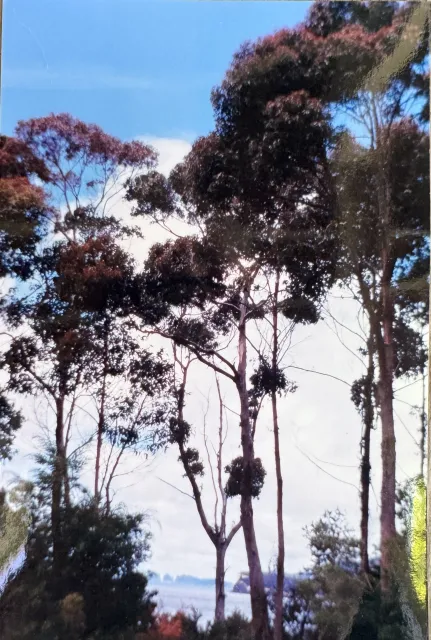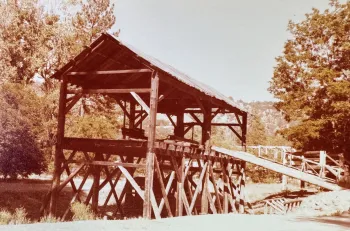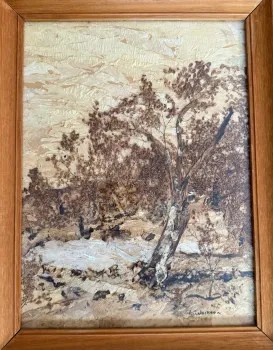
Article by Peg Smith -
First a quick ramble through California’s history…
Why does California history have anything to do with eucalypts? It gives perspective to the increasing human presence in California and an example of the subsequent effects and changes in original flora and fauna of California. The elevation to statehood of California and the arrival of eucalypts are tied together by relatively recent historical events that brought tremendous changes to California.
Native Americans tribes thrived in California for approximately fourteen thousand years before European contact.
1542 – Following Cabrillo’s Spanish sailing expedition, which was the first European contact with Californian Native American tribes, the Spanish claimed Baja California and Alta California which encompassed a large region of the west.
1769 to 1834 - The first Mission was established in San Diego in 1769, the Mission system was secularized in 1834. The pueblos (towns) that were developed to support the Missions and the Presidios (forts) such as San Diego, Santa Barbara and Monterey continued as established small population centers.
1821 to 1848 - Mexico gained its independence from Spain in 1821, assuming governance of Alta California with the capital in Monterey. During the Spanish period, land grants had been given to government officials, friends, and family of the governors. The Mexican government established a land grant process through which settlers could apply.
California was an isolated and sparsely populated territory. The Native American population had been decimated by exposure to diseases and harsh conditions since the first European contact. The non-native population of California around 1845 was about ten thousand, which included only thirteen hundred Americans and five hundred European immigrants. The majority of the population had Spanish or Latin American roots.
In 1839 John Sutter was given a land grant in the Central Valley. It was the first non-native settlement reaching into the interior of California. Americans were the predominant settlers around the fort. The first Yolo County land grant was given in 1842.
1846 to1847 - With disputes over territory in the Mexican-controlled Republic of Texas, America annexed Texas from Mexico in 1845, with Congress issuing a declaration of war with Mexico in 1846. Alta California became involved in the war with Mexico with the Bear Flag Rebellion when a group of American citizens took over the control of the small garrison of Sonoma. Governance of the garrison transferred to the US in less than a month.
1847 and 1848 Treaties, ending the Mexican American War, were signed, with the US assuming control of Texas, California, and other western territories.

Meanwhile, in the Central Valley, Sutter’s Fort was thriving. James Marshall, a carpenter regularly traveling up into the Sierra foothills to cut lumber for construction,and discovered gold in the water of the millrace at the end of January 1848. A twist of fate indeed - Mexico finally ceded California to the US in February of 1848, just after gold was discovered! California’s future became very different from its mostly pastoral past. As word spread about the discovery of gold, the change in California was exponential. San Francisco became the official port of entry for the gold fields. In 1846, San Francisco had a population of 200, by 1852, the population had grown to 36,000.
Most of the hillside oaks around settlements had been cut and used. Now, the amount of wood needed to provide shipping, energy, building materials, carriages, wagons, plank sidewalks, railroad ties, mine shaft linings, was a demand to be met. Many of the immigrant gold seekers were Australian and brought seeds from home, including those of the Tasmanian blue gum (Eucalyptus globulus), which is the predominant species we see in California. In 1853, Captain Robert H. Waterman, a clipper ship captain, retired to the Suisun Valley, where he was involved with the laying out of the cities of Fairfield and Cordelia. His city designs incorporated plantings of blue gum, distributing the seeds to friends and new settlers. Many of these original plantings are still seen along the roadsides. Blue gum was found to grow well in the California coastal climate. With its natural rapid growth of four to six feet per year, achieving seventy percent of its height in ten years, at the time, it was thought that creating plantations of blue gum would solve the urgent need for timber. Since it was introduced by seed to California, none of the native pathogens or pests were introduced, and the trees thrived.
Unfortunately, although the blue gum had the positive attribute of rapid growth, it was notorious for twisting and splitting. As it dried, it became as hard as a rock, so it was unusable by the railroad; even the strongest could not drive a railroad spike through it. This put an end to the idea of railway lines flanked by eucalypts providing timber for railroad tie repair and buildings. The stands of blue gum were left abandoned. Their most effective use was in creating windbreaks. For example, Berkeley planted a eucalyptus windbreak in the 1880s to reduce the wind blowing ash up onto the athletes on an early cinder athletic track.
In the nineteen hundreds, there was a concern that over-logging of the eastern forests would result in a ‘timber famine.’ With the extensive harvesting of California oak and redwood, coupled with the great demand for timber to rebuild San Francisco, eucalyptus was again proposed as a solution. Millions of eucalypts were planted from Southern California to the Bay Area. Landowners were enticed by statements such as ‘Forests While You Wait,’ but once again, the natural characteristics of the eucalyptus wood were not suited to the purpose. Author Jack London was one Sonoma County landowner who thought a fortune was to be made from eucalyptus timber. Around 1910, he met with professors at UC Davis to discuss his interest in planting eucalyptus across the state. He began with a planting of fifteen thousand trees on his ranch. After removing the property’s existing vineyard grapes, he planted an additional 100,000 eucalypts. Over time, at a cost of $100,000, Jack London planted about 200,000 eucalypts.
The eastern forests recovered somewhat, imports of timbers such as mahogany and the increased use of concrete and steel meant the many eucalyptus entrepreneurs were left with acres of unusable timber. Many of the stands we see today are the aging trees of this time of rapid eucalyptus planting.
What to do now that they are established in California?
The Tasmanian blue gum is considered a moderately invasive species, as it needs specific moisture conditions to thrive and for seed germination, so it does not spread aggressively to drier regions. However, the temperate conditions and fog belt of the coastal region are conducive to its healthy survival. One drawback was the need for moisture to support its rapid growth. It became common for wells to dry up when near eucalyptus plantations. It is a resilient tree; after drought, fire or low temperatures, existing foliage may die back, but the tree will regenerate masses of new shoots.

In Australia, there is a developed ecosystem of mammals, insects, flora, etc. that provides a diverse ecosystem. But California eucalyptus groves are generally a monoculture because native birds, insects, flora, and fauna are not adapted to the toxins contained in the leaves and bark of the eucalypts.
One adaptation has been in the western monarch butterfly. They not only collect in numbers to winter over in the traditional trees such as Monterey pine but now also rely upon the groves of eucalypt such as those in Santa Cruz to provide a resting place during the winter.
There have been several deforestation programs of eucalyptus groves, but the effort required is intense, as any stump will resprout, producing many shoots. Stumps need to be dug up, treated by painting a coat of herbicide over the cambium layer or by covering the stump with tightly sealed black plastic, which is then covered by a deep layer of mulch.
Many of the stands we see are the remnants of the original plantings, and trees are in rows with few saplings. Climate change may slow the spread or rejuvenation of the eucalyptus groves as the seeds need a specific amount of moisture to germinate. As trees age and die, the eucalypt may fade from the California landscape except as a chosen garden specimen tree.
Eucalyptus foliage contains oil, which is quite flammable, but the main cause of concern for fire danger is the bark that continually peels and is regrown; this creates a layer of highly flammable fuel called ‘duff’ beneath a dense growth of eucalypts. Burning duff beneath the trees is easily lifted and disbursed by the wind, causing spot fires at distances, making containment and control of a fire difficult.
On larger properties, it is recommended that eucalypts be maintained one hundred feet away from structures and fifteen feet from roadways. If you have a mature eucalypt in your garden, it is recommended that the lower branches be removed up to ten feet from the ground and away from the roof. If the tree is less than thirty feet tall, remove lower limbs up to a third of the tree height. Make sure there is canopy separation to other trees. Clear all ‘ladder’ fuel plants from around the trees. It is also important to clean up any bark or leaf debris. Broken into pieces, the bark makes a great medium for orchid growing.
It is tempting to put a few seeds in a pocket when traveling from home, but resist. Throughout human history the best of intentions or solutions have often created either more problems or had catastrophic effects on the existing ecosystem. As gardeners, we can recommend proven plants for our region and discourage and educate about known invasives, no matter how attractive.

